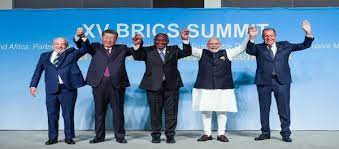APA-Pretoria (South Africa) The BRICS group of the world’s top emerging economies has agreed to expand its membership by inviting Argentina, Egypt, Ethiopia, Iran, Saudi Arabia and the United Arab Emirates to become new members, South African President Cyril Ramaphosa said on Thursday.
Ramaphosa, who is the current BRICS chairperson, said the five-member bloc has “reached agreement on the guiding principles, standards, criteria and procedures of the BRICS expansion process.”
“We have consensus on the first phase of this expansion process,” the South African leader said in a speech delivered on the last day of a two-day BRICS summit.
He added: “We have decided to invite the Argentine Republic, the Arab Republic of Egypt, the Federal Democratic Republic of Ethiopia, the Islamic Republic of Iran, the Kingdom of Saudi Arabia and the United Arab Emirates to become full members of BRICS from 1 January 2024.”
BRICS is currently made up of the emerging economies of Brazil, Russia, India, China and South Africa.
At least 23 countries had expressed interest to join the bloc ahead of the summit and the admission of the six is the first phase of a gradual process aimed at transforming BRICS into a viable alternative to the current unipolar global setup dominated by Western countries.
This is the second time that BRICS has decided to expand. The bloc was formed in 2009 by Brazil, Russia, India and China. South Africa was added in 2010.
The admission of the six countries is expected to solidify efforts by the bloc to become a strong global player in the face of an increasingly polarised global geopolitical environment dominated by the United States and its Western allies.
As part of efforts to wean developing countries from Western-controlled multilateral financial institutions such as the International Monetary Fund and World Bank, the BRICS group is contemplating establishing a currency that would rival the dominance of the US dollar as the preferred global medium of exchange.
The idea of a BRICS currency is not new. It was first proposed by Russia in 2009, but met with scepticism and resistance from other members, especially China, which at the time had its own ambitions to internationalise its currency, the Renminbi.
However, recent developments have given new impetus to the proposal. These include the rising US interest rates and debt-ceiling crisis, which have raised concerns about the stability and sustainability of the dollar.
Other push factors include the escalating trade war between the US and China, which has threatened global growth and stability, as well as Beijing’s growing assertiveness in global affairs which has increased its influence and leverage among other developing countries.
In addition, the recent diplomatic tiff between Russia and most Western capitals over its invasion of Ukraine has buttressed calls for an alternative currency that cannot be manipulated by the West.
The proposed BRICS currency would offer several benefits for the bloc and beyond, according to analysts.
For instance, the currency is expected to reduce transaction costs and exchange rate risks for trade and investment among the BRICS countries, which presently account for more than 40 percent of the world population and about 26.6 percent of global gross domestic product.
It would enhance financial stability and resilience for the BRICS nations and other developing countries, which have faced volatility and vulnerability due to external shocks such as sanctions.
It would reflect the growing economic weight and political voice of the BRICS countries in global governance and decision-making.
However, there are also many challenges and uncertainties facing the BRICS currency project.
These include the significant differences and divergences among the BRICS countries in terms of their economic size, structure, performance, development level, policy orientation and strategic interests.
For example, China, which is by far the largest and most influential member of the bloc, accounting for about 70 percent of its GDP.
This raises questions about how the new currency would be designed, governed and managed in a fair and balanced way that respects the sovereignty and autonomy of each member.
JN/APA


